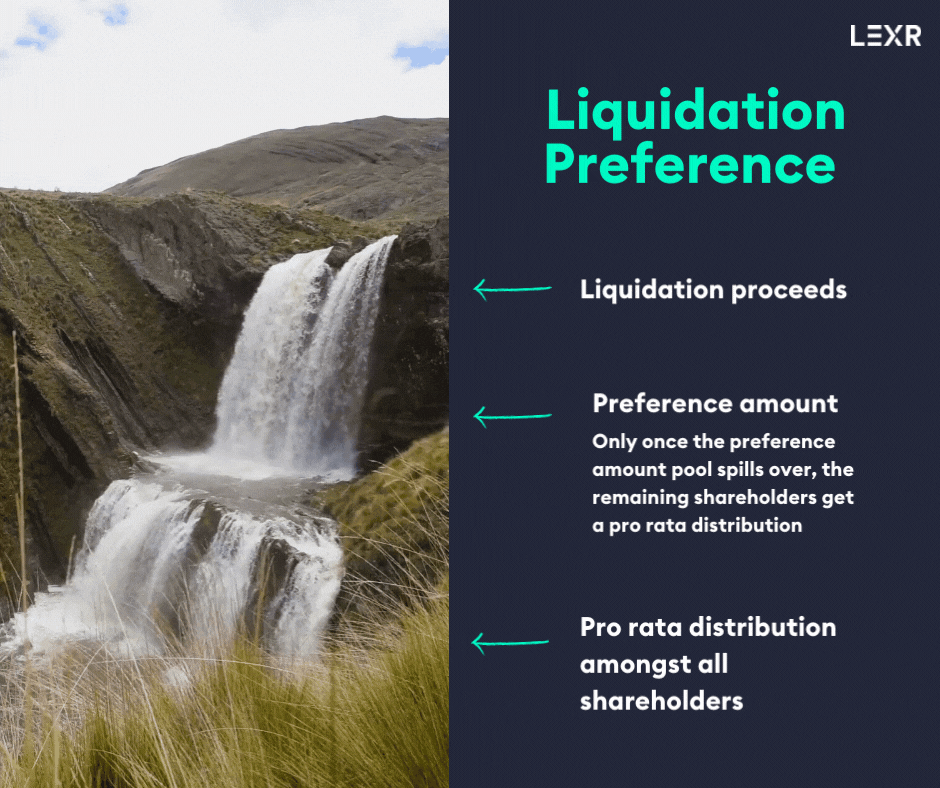In the first blog article about Liquidation Preferences in financing rounds, we have introduced the basics concepts and highlighted some of the points that need closer attention when drafting or negotiating a Liquidation Preference clause. In this second blog article, we will look at (i) the events that trigger the Liquidation Preference, (ii) the Preference Amount and (iii) design options of the Liquidation Preference clause.
1 When is the Liquidation Preference triggered (Liquidity Events)?
First, it has to be defined in which event the Liquidation Preference applies. In other words, what events lead to a pay-out to the shareholders. Typically, the Liquidity Events are defined as:
- Exit: if the shareholders (or at least 50% of the shareholders) exit the company by selling their shares to third parties;
- Liquidation: any liquidation, dissolution, winding-up, or capital decrease of the company;
- Merger and other reorganizations: if the company merges with another company, absorbs another company, or is absorbed by another company; and
- IPO: the initial public offering of shares of the company on a security exchange
The proceeds resulting from a Liquidity Event are called Liquidation Proceeds.
Pro-tip: Always carefully check the definitions. Sometimes, dividend payments are included in the Liquidity Event or the Liquidity Proceeds. Don’t let someone smuggle a factual prohibition of dividends into the contract by changing the wording in a definition.
Should the dividends be included, all dividend payments up to the Preference Amount will go exclusively to the investor.
2 Up to what amount are investors given preference (Preference Amount)?
As explained in the first blog post, the Liquidation Preference protects the investment of the investor. But how high exactly is this so-called Preference Amount?
To calculate the Preference Amount, the number of shares held by the investor at the time of the Liquidity Event is multiplied by the issue price that the investor paid for these shares.
Example: If an investor has subscribed for 1’000 shares (and still holds 1’000 shares) at an issue price of CHF 1’000, the Preference Amount equals CHF 1’000’000.
Possibly the investor has received distributions before the Liquidity Event (typically in the form of dividends), which should be subtracted from this amount.
Example: If the investor has already received dividends in the amount of CHF 100’000, the Preference Amount is reduced to CHF 900’000.
In short: Preference Amount = number of shares held by the investor multiplied by the issue price of these shares minus any received distributions.
3 How is the preference amount protected (Liquidation Preference)?
3.1 Standard (1x Non-Participating)
If the total Liquidation Proceeds are not sufficient to cover the investor’s investment, the Liquidation Preference kicks in to protect the investment made by the investor. In other words: If a pro-rata distribution of the Liquidation Proceeds is high enough to cover the investor’s investment, there is no need for the Liquidation Preference to be triggered
In essence, the Liquidation Preference works like a waterfall under which different pools are placed in a way that the water first flows into one pool, and only when this pool spills over, the water flows into the next pool below it.
- The source of the water is the Liquidity Event;
- the depth of the first pool is the Preference Amount; and
- the layout of the pools is the Liquidation Preference.
By placing the “Preference Amount pool” above the pool to which all shareholders have a claim, it is ensured that the investor’s claim is actually treated in preference to all other claims. Once the “Preference Amount pool” has been completely filled with Liquidation Proceeds, the overflowing Liquidation Proceeds flow pro-rata into the next pool available to the remaining shareholders.

3.2 Variations (Multiple x-Participating)
In the layout described above, the investor gets back his/her/its investment exactly one time, for which reason this design of the Liquidation Preference is called 1x. Also, the investor does not take part in the distribution of the Liquidation Proceeds that have spilled over the preferred pool into the common pool of the remaining shareholders, which is why the Liquidation Preference is non-participating. A 1x non-participating Liquidation Preference serves as a pure downside risk protection.
Example: If the Preference Amount is CHF 1’000’000, the investor’s protected amount in a Liquidity Event is one time the Preference Amount, i.e. CHF 1’000’000.
It is also possible to increase the share of the Liquidation Proceeds that the investor shall receive:
On one hand, it can be agreed that the investor may recover the Preference Amount more than once, e.g. two times. In this case, a 2x Liquidation Preference applies.
Example: If the Preference Amount is CHF 1’000’000, the investor’s protected amount in a Liquidity Event is two times the Preference Amount, i.e. CHF 2’000’000.
On the other hand, it can be agreed that once the “Preference Amount pool” is full, the investor may participate (“double-dip”) in the remaining proceeds to be distributed amongst all other shareholders. This would then be called a participating Liquidation Preference.
Example: The Liquidation Proceeds are CHF 2’000’000 and the investor has a 25% stake in the company which he/she/it acquired at a valuation of the company of CHF 4’000’000 (i.e. for CHF 1’000’000, which means the Preference Amount is CHF 1’000’000).
With a participating liquidation preference clause, the investor will first get CHF 1’000’000 of the total proceeds of CHF 2’000’000. In addition, the investor can participate (“double-dip”) in the remaining CHF 1’000’000 pro-rata according to his/her/its stake of 25%. The investor will thus receive CHF 1’250’000 in total.
It is also possible to combine a “multiple x” with a participating preference, e.g. a 2x-participating Liquidation Preference.
4 More than one class of preferred shares
In this blog post, we assume that there is only one class of preferred shares. Nevertheless, it is possible to have more than one class of preferred shares. This typically happens in later financing rounds, such as in a Series B round. In this case, one or more preferred pools are introduced below the waterfall. The implication of this is that the investor with the highest preference may recover his/her/its investment before the investors with a lower preference, who in turn may recover their investment before any common shareholders receive their share of the Liquidation Proceeds.
Such preferential rights are usually granted according to the concept of last in – first out. This means that the newest investors will have the highest preference.
5 Summary and outlook
In this second blog post of our mini-series, the inner workings of a Liquidation Preference were examined. First, we discovered that the Liquidation Preference is triggered by certain Liquidity Events, such as an exit, a liquidation, a merger, or an IPO. Second, the Preference Amount was discussed, i.e. the amount to be paid to the investor in case of a Liquidity Event that shall be treated preferentially. The Preference Amount corresponds to the number of shares held by the investor at the time of the Liquidity Event multiplied by the issue price less any distributions already received. In the third and main part, the functioning of the Liquidation Preference was explained for a 1x non-participating clause. It only kicks in if the Preference Amount is not satisfied in a pro-rata distribution of the Liquidation Proceeds among all shareholders. Once it kicks in, it ensures that the investor first receives its Preference Amount before any remaining Liquidation Proceeds are distributed among the other shareholders. Also, we looked into variations of a Liquidation Preference, namely “multiple x” and participating clauses. In this case, the Preference Amount is not only paid out once but multiple times, and/or the investor can participate in the distribution of the remaining Liquidation Proceeds after the Preference Amount has been recovered.
Having now gained an understanding of how Liquidation Preferences work in theory, we shall put this knowledge to use in the third blog post of our mini-series. In this final post, we will present you with a best practice example of a Liquidation Preference clause. As always: Stay tuned!












